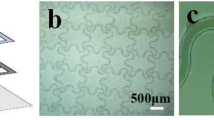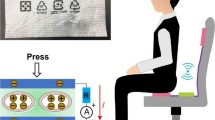Abstract
Recently, human physiological information wireless monitoring in real-time is particularly important in health analysis. As a solution, a non-contact wireless physiological monitoring system based on pyroelectric generator (PyG), whose core part consists of a wireless circuit processing module and a polyvinylidene fluoride (PVDF) film, has been successfully designed. Owing to the temperature change under the stimulation of an external heat source, the output voltage of the PyG self-powered flexible sensor increases with the heat source temperature variation in the range of 295–355 K. Furthermore, based on the natural temperature oscillation between the living body and surrounding environment, the sensor can realize human physiological information assessment, for example, temperature monitoring of the palms, fingers, respiratory heat signals from mouth or nose or non-contact spatial heat mapping recognition of finger movement via sensor array. On this basis, a portable wireless monitoring system was designed by integrating the intelligent sensor with a signal conditioning circuit, data conversion storage module, Bluetooth module, and power module. This system can acquire real-time human oral or nasal breathing signals in the personal mobile app to evaluate the physiological state of individuals. Additionally, the wireless monitoring system can be activated within 10 m, demonstrating the application of PyG sensors in remote data transmission.
Similar content being viewed by others
References
Lu C F, Wu S, Zhang Y Y, et al. Electromechanical modeling of eye fatigue detecting using flexible piezoelectric sensors. Sci China Inf Sci, 2018, 61: 060417
Hu X H, Zhang X, Liu M, et al. A flexible capacitive tactile sensor array with micro structure for robotic application. Sci China Inf Sci, 2014, 57: 120204
Han L B, Ding J N, Wang S, et al. Multi-functional stretchable and flexible sensor array to determine the location, shape, and pressure: application in a smart robot. Sci China Tech Sci, 2018, 61: 1137–1143
Gao L, Hu D, Qi M, et al. A double-helix-structured triboelectric nanogenerator enhanced with positive charge traps for self-powered temperature sensing and smart-home control systems. Nanoscale, 2018, 10: 19781–19790
He J, Wen T, Qian S, et al. Triboelectric-piezoelectric-electromagnetic hybrid nanogenerator for high-efficient vibration energy harvesting and self-powered wireless monitoring system. Nano Energy, 2018, 43: 326–339
Strauß R, Ewig S, Richter K, et al. The prognostic significance of respiratory rate in patients with pneumonia: a retrospective analysis of data from 705928 hospitalized patients in Germany from 2010–2012. Deutsches Aerzteblatt Online, 2014, 111: 503–508
Trung T Q, Lee N E. Flexible and stretchable physical sensor integrated platforms for wearable human-activity monitoringand personal healthcare. Adv Mater, 2016, 28: 4338–4372
Webb R C, Bonifas A P, Behnaz A, et al. Ultrathin conformal devices for precise and continuous thermal characterization of human skin. Nat Mater, 2013, 12: 938–944
Yokota T, Inoue Y, Terakawa Y, et al. Ultraflexible, large-area, physiological temperature sensors for multipoint measurements. Proc Natl Acad Sci USA, 2015, 112: 14533–14538
Guo W, Tan C, Shi K, et al. Wireless piezoelectric devices based on electrospun PVDF/BaTiO3 NW nanocomposite fibers for human motion monitoring. Nanoscale, 2018, 10: 17751–17760
He X, Zi Y, Yu H, et al. An ultrathin paper-based self-powered system for portable electronics and wireless human-machine interaction. Nano Energy, 2017, 39: 328–336
Jeon J, Lee H B R, Bao Z. Flexible wireless temperature sensors based on Ni microparticle-filled binary polymer composites. Adv Mater, 2013, 25: 850–855
Li Q, Zhang L N, Tao X M, et al. Review of flexible temperature sensing networks for wearable physiological monitoring. Adv Healthcare Mater, 2017, 6: 1601371
Youn D Y, Jung U, Naqi M, et al. Wireless real-time temperature monitoring of blood packages: silver nanowire-embedded flexible temperature sensors. ACS Appl Mater Interfaces, 2018, 10: 44678–44685
Pereira C B, Yu X, Czaplik M, et al. Estimation of breathing rate in thermal imaging videos: a pilot study on healthy human subjects. J Clin Monit Comput, 2017, 31: 1241–1254
Li W, Liang T, Liu W, et al. Wireless passive pressure sensor based on sapphire direct bonding for harsh environments. Sens Actuat A-Phys, 2018, 280: 406–412
Chen W, Liu P, Liu Y, et al. A temperature-induced conductive coating via layer-by-layer assembly of functionalized graphene oxide and carbon nanotubes for a flexible, adjustable response time flame sensor. Chem Eng J, 2018, 353: 115–125
Tai Y, Chen T, Lubineau G. A sandwiched/cracked flexible film for multithermal monitoring and switching devices. ACS Appl Mater Interfaces, 2017, 9: 32184–32191
Hong S Y, Lee Y H, Park H, et al. Stretchable active matrix temperature sensor array of polyaniline nanofibers for electronic skin. Adv Mater, 2016, 28: 930–935
Liu Q, Tai H, Yuan Z, et al. A high-performances flexible temperature sensor composed of polyethyleneimine/reduced graphene oxide bilayer for real-time monitoring. Adv Mater Technol, 2019, 4: 1800594
Ren X, Pei K, Peng B, et al. A low-operating-power and flexible active-matrix organic-transistor temperature-sensor array. Adv Mater, 2016, 28: 4832–4838
Yu J, Hou X, Cui M, et al. Highly skin-conformal wearable tactile sensor based on piezoelectric-enhanced triboelectric nanogenerator. Nano Energy, 2019, 64: 103923
Yu J, Hou X, He J, et al. Ultra-flexible and high-sensitive triboelectric nanogenerator as electronic skin for self-powered human physiological signal monitoring. Nano Energy, 2020, 69: 104437
Ebrahim S, Elshaer A M, Soliman M, et al. Pyroelectric infrared detector based on polyaniline/polyvinylidene fluoride blend. Sens Actuat A-Phys, 2016, 238: 389–396
Wu Q, Li X, Yang X, et al. Pyroelectric infrared device with overlap dual capacitor structure sensor. Sens Actuat A-Phys, 2018, 282: 192–196
Zi Y, Lin L, Wang J, et al. Triboelectric-pyroelectric-piezoelectric hybrid cell for high-efficiency energy-harvesting and self-powered sensing. Adv Mater, 2015, 27: 2340–2347
You M H, Wang X X, Yan X, et al. A self-powered flexible hybrid piezoelectric-pyroelectric nanogenerator based on non-woven nanofiber membranes. J Mater Chem A, 2018, 6: 3500–3509
Leng Q, Chen L, Guo H, et al. Harvesting heat energy from hot/cold water with a pyroelectric generator. J Mater Chem A, 2014, 2: 11940–11947
Zhang H, Xie Y, Li X, et al. Flexible pyroelectric generators for scavenging ambient thermal energy and as self-powered thermosensors. Energy, 2016, 101: 202–210
Sun J G, Yang T N, Wang C Y, et al. A flexible transparent one-structure tribo-piezo-pyroelectric hybrid energy generator based on bio-inspired silver nanowires network for biomechanical energy harvesting and physiological monitoring. Nano Energy, 2018, 48: 383–390
Xue H, Yang Q, Wang D, et al. A wearable pyroelectric nanogenerator and self-powered breathing sensor. Nano Energy, 2017, 38: 147–154
Mahbub I, Pullano S A, Wang H, et al. A low-power wireless piezoelectric sensor-based respiration monitoring system realized in CMOS process. IEEE Sens J, 2017, 17: 1858–1864
Zhang B, Tang Y, Dai R, et al. Breath-based human-machine interaction system using triboelectric nanogenerator. Nano Energy, 2019, 64: 103953
Zhang H, Zhang J, Hu Z, et al. Waist-wearable wireless respiration sensor based on triboelectric effect. Nano Energy, 2019, 59: 75–83
Liu H, Allen J, Zheng D, et al. Recent development of respiratory rate measurement technologies. Physiol Meas, 2019, 40: 07TR01
Yang Y, Jung J H, Yun B K, et al. Flexible pyroelectric nanogenerators using a composite structure of lead-free KNbO(3) nanowires. Adv Mater, 2012, 24: 5357–5362
Tien N T, Seol Y G, Dao L H A, et al. Utilizing highly crystalline pyroelectric material as functional gate dielectric in organic thin-film transistors. Adv Mater, 2009, 21: 910–915
Lang S B. Pyroelectricity: from ancient curiosity to modern imaging tool. Phys Today, 2005, 58: 31–36
Cuadras A, Gasulla M, Ferrari V. Thermal energy harvesting through pyroelectricity. Sens Actuat A-Phys, 2010, 158: 132–139
Kano S, Dobashi Y, Fujii M. Silica nanoparticle-based portable respiration sensor for analysis of respiration rate, pattern, and phase during exercise. IEEE Sens Lett, 2018, 2: 1–4
Pang Y, Jian J, Tu T, et al. Wearable humidity sensor based on porous graphene network for respiration monitoring. Biosens Bioelectron, 2018, 116: 123–129
Lv R, Li S, Jin T, et al. Hybrid core-shell nanofibers as moisture sensors for human breath monitoring. Compos Sci Tech, 2018, 162: 58–63
Janik P, Pielka M, Janik M A, et al. Respiratory monitoring system using Bluetooth low energy. Sens Actuat A-Phys, 2019, 286: 152–162
Qiu H J, Song W Z, Wang X X, et al. A calibration-free self-powered sensor for vital sign monitoring and finger tap communication based on wearable triboelectric nanogenerator. Nano Energy, 2019, 58: 536–542
Güder F, Ainla A, Redston J, et al. Paper-based electrical respiration sensor. Angew Chem Int Ed, 2016, 55: 5727–5732
Acknowledgements
This work was supported by National Natural Science Foundation of China (Grant Nos. 51705476, 51975542), National Key R&D Project of China (Grant Nos. 2018YFF0300605, 2019YFF0301802), Shanxi “1331 Project” Key Subject Construction (Grant No. 1331KSC), Young Academic Leaders of North University of China (Grant No. QX201805), Program for the Innovative Talents of Higher Education Institutions of Shanxi, and Applied Fundamental Research Program of Shanxi Province (Grant Nos. 201801D221199, 201901D211281). The volunteer who participated in human testing provided informed consent.
Author information
Authors and Affiliations
Corresponding authors
Additional information
Supporting information
Figures S1–S6, Table S1, Videos S1–S3. The supporting information is available online at info.scichina.com and link.springer.com. The supporting materials are published as submitted, without typesetting or editing. The responsibility for scientific accuracy and content remains entirely with the authors.
Supporting Information
Supplementary material, approximately 16.5 MB.
Supplementary material, approximately 6.39 MB.
Supplementary material, approximately 10.7 MB.
Rights and permissions
About this article
Cite this article
He, J., Li, S., Hou, X. et al. A non-contact flexible pyroelectric sensor for wireless physiological monitoring system. Sci. China Inf. Sci. 65, 122402 (2022). https://doi.org/10.1007/s11432-020-3175-6
Received:
Revised:
Accepted:
Published:
DOI: https://doi.org/10.1007/s11432-020-3175-6




